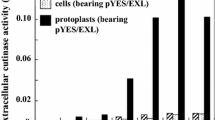Abstract
The sweet protein monellin gene was expressed in Saccharomyces cerevisiae under the control of the GAL1 promoter and α-factor signal peptide sequence of S. cerevisiae. The gene, which was obtained through mutation of the synthesized single-chain monellin gene, was cloned into an E. coli-yeast shuttle vector pYES2.0 which carries the galactose-inducible promoter GAL1. Then the α-factor signal peptide of S. cerevisiae was linked also, resulting in the secreting expression vector pYESMTA. The recombinant plasmid was subsequently transformed into strain S. cerevisiae INVsc1. The peptide efficiently directed the secretion of monellin from the recombinant yeast cell. A maximum yield of active monellin was 0.41 g l−1 of the supernatant from INVsc1 harboring pYESMTA.





Similar content being viewed by others
References
Chen ZJ, Cai H, Lu FP, Du LX (2005) High-level expression of a synthetic gene encoding a sweet protein, monellin, in Escherichia coli. Biotechnol Lett 27:1745–1749
Chen ZJ, Cai H, Li ZY, Liang XL, Shangguan XC (2007) Expression and secretion of a single-chain sweet protein monellin in Bacillus subtilis by sacB promoter and signal peptide. Appl Microbiol Biotechnol 73:1377–1381
Douglas M, Maria JQ, Maria DL, Cruz MC, Sebastian C (2008) Systems for applied gene control in Saccharomyces cerevisiae. Biotechnol Lett 30:979–987
Gietz RD, Woods RA (2002) Transformation of yeast by the LiAc/ss carrier DNA/PEG method. Methods Enzymol 350:87–96
Kim SH, Kang CH, Cho JM, Lee TK (1989) Redesigning a sweet protein: increased stability and renaturability. Protein Eng 2:571–575
Kondo K, Miura Y, Song H, Kobayashi K (1997) High level expression of a sweet protein, monellin, in the food yeast Candida utilis. Nat Biotechnol 15:453–457
Liu WF, Gao D, Bao XM (1998) The study of functional performance of inducing-promoter in S. cerevisiae. J Shandong Univ (Chin) 33:345–349
Morris JA, Cagan RH (1972) Purification of monellin, the sweet principle of Discorephyllum cumminisii. Biochiem Biophys Acta 261:114–122
Sambrook J, Fritsch EF, Maniatis T (1989) Molecular cloning: a laboratory manual. Cold Spring Harbor Laboratory Press, New York
Southgate VJ, Steyn AJ, Pretorius IS, Van Vuuren HJ (1993) Expression and secretion of Bacillus amyloliquefaciens alpha-amylase by using the yeast pheromone alpha-factor promoter and leader sequence in Saccharomyces cerevisiae. Appl Environ Microbiol 59:1253–1258
Zhang XL, Ito T, Kondo K, Kobayashi T, Honda H (2002) Production of single chain recombinant monellin by high cell density culture of genetically engineered Candida utilis using limited feeding of sodium ions. J Chem Eng Jpn 35:654–659
Author information
Authors and Affiliations
Corresponding author
Rights and permissions
About this article
Cite this article
Chen, Z., Li, Z., Yu, N. et al. Expression and secretion of a single-chain sweet protein, monellin, in Saccharomyces cerevisiae by an α-factor signal peptide. Biotechnol Lett 33, 721–725 (2011). https://doi.org/10.1007/s10529-010-0479-2
Received:
Accepted:
Published:
Issue Date:
DOI: https://doi.org/10.1007/s10529-010-0479-2




